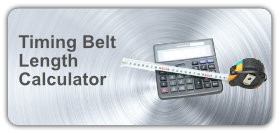Excessive Temperature of Belt, Bearings, Housings, Shafts, Etc.
The timing belt material used in urethane timing belts is thermoplastic, meaning it has a melting point. When subjected to environmental temperatures in excess of 185°F, the timing belt teeth may begin to soften and deform. In addition, the tensile cord to urethane adhesion loses its integrity.
When rubber timing belts operate at elevated temperatures (greater than 185°F) for prolonged periods of time, the timing belt material gradually hardens resulting in back cracking due to bending. These cracks typically remain parallel to the timing belt teeth and usually occur over land areas (in between timing belt teeth). This typically results in timing belts failure due to tooth shear, which often leads to tensile cord fracture.
Probable Cause:
- Misaligned drive
Corrective Action:
- Check parallel and angular alignment of the timing belt pulleys
Probable Cause:
- Too low or high of tension
Corrective Action:
- Adjust tension to recommended value
Probable Cause:
- Incorrect timing belt tooth profile for the timing belt pulley
Corrective Action:
- Check timing belt / timing belt pulley compatibility







